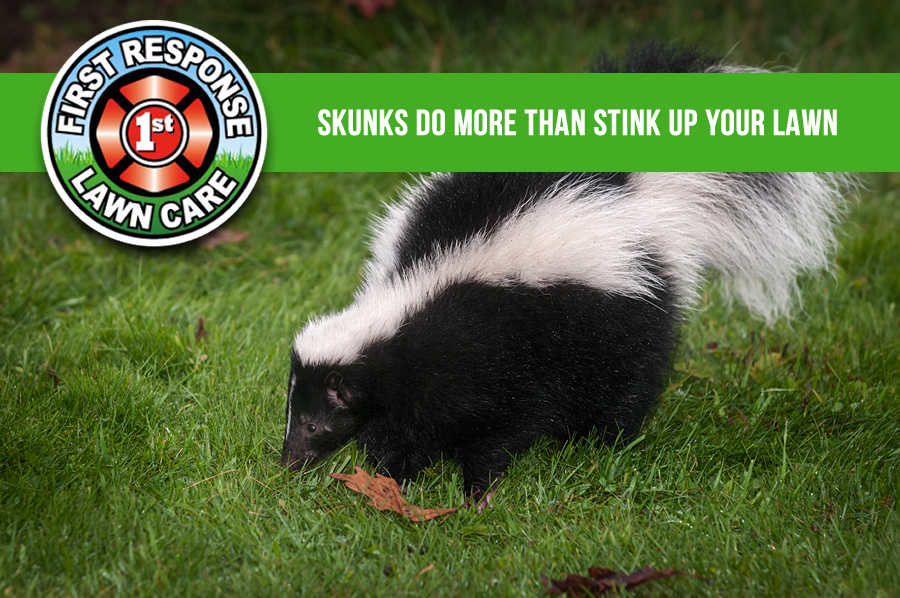We’ve been smelling a lot of skunks in our yard lately. Typically it’s when we take the dogs out later in the evening. So today’s topic is on skunks and your lawn.
Those cute little black and white striped skunks are nocturnal animals that are naturally mild-mannered and non-aggressive. They prefer small animals and insects for dinner instead of your lawn and garden. They do occasionally visit gardens and if they do, it may be because corn or other plants are close to the ground.
Skunks can be very nice to have around because they dig up and feed on grubs and other crop-destroying insect life. However, skunks are not partial to insects. They will eat leaves, buds, grasses, grains, garbage, any fruit or berries within reach, and even small game. This is what can make them a bit of a nuisance.
Why do skunks spray?
You can smell an angry skunk from miles away. A skunk can spray you from 10 to 12 feet, sideways, up, or down, with little apparent effort. Most gardeners worry more about a skunk spraying in the garden, on the gardener, or on a pet than about a skunk chewing up their lawn and garden.
Under a skunk’s tail are a pair of ducts which, in peacetime, remain hidden, but which emit a foul ammunition when they are upset. Each of the two pouches contains enough ammunition for six rounds. After the supply is exhausted, it takes a week for the liquid to replenish.
A skunk’s warfare is purely defensive. When confronted by a menacing man or clamorous dog, skunks will try to sidestep by ambling off. This means that if you find a skunk, simply turn back and you should be fine. If pursued, skunks will turn, face their aggressor, and stamp their forefeet. This is their first warning and you should run!
The second warning comes when their tails, all but the tips, are hoisted and the spray is released. People can get sprayed when they walk through their yard in the dark or disturb a skunk while eating.
How do you know if you have skunks in your garden?
Skunks are often mistaken for raccoons, because they both have five toes. Sometimes the fifth toe is hard to see in skunk tracks. Their heels usually are not part of the tracks, and their claw marks are usually somewhat visible. Often, the best way to identify skunks is unfortunately by their odor.
If your lawn or flower bed has lots of holes in it, you may have a skunk problem. Skunks dig up the turf looking for grubs. They move around at night and dig in grassy areas, making distinct 3– to 4–inch deep holes. Skunk activity increases in the spring and then lessens naturally, so any problems may stop all on their own.
Skunks sometimes feed on corn, but they only eat the lower ears. If a corn stalk has been toppled over, the culprit is more likely a raccoon. Planting taller varieties of corn can minimize this damage.
How do you get rid of skunks?
- Probably the best skunk repellent is a light. Skunks are nocturnal and their eyes are very light sensitive. A bright light or a motion sensor flood light will scare skunks away.
- Most animals, including skunks, dislike the smell of citrus fruits. Place orange or lemon peels around the yard as a natural skunk repellent.
- Spray a mixture of castor oil and dish-washing detergent diluted in water. Skunks find the smell offensive. Spray the area at night when the skunk is away foraging.
- Predator urine (e.g. dogs) can be used to repel a skunk. These are commercially sold in garden centers.
- If the skunks are in a smaller garden patch, put bars of strong–smelling soap or a room deodorizer near your garden. Skunks hate strong scents.
- If nothing works, there are humane ways for professionals to trap skunks and transport them elsewhere. Often, skunk removal by trapping is the only answer, and there just isn’t a lot you can do if it is a skunk.
- One of the best preventative methods is to treat your lawn so that you get rid of the skunk’s favorite snacks–insects.
What do you do if you or a pet are spayed by a skunk?
If you or your pet is sprayed by a skunk, try a mixture of 1 quart 3% hydrogen peroxide, ¼ cup of baking soda, and 2 teaspoons of liquid dish soap. Shampoo only the area sprayed by the skunk. We recommend wearing rubber gloves. Then using a sponge or washcloth, wet the area and work the solution into the skin (or fur) with your hands avoiding the eyes. Then rinse. There are also commercial skunk odor removers like Nature’s Miracle Skunk Odor Removal.
Hydrogen peroxide and baking soda convert the skunk musk into an odorless chemical, and the soap in the mixture breaks down the oily residue so the other chemicals can work.
First Response Lawn Care provides expert lawn treatment. Call us today to get started on a lawn treatment plan for your lawn.

